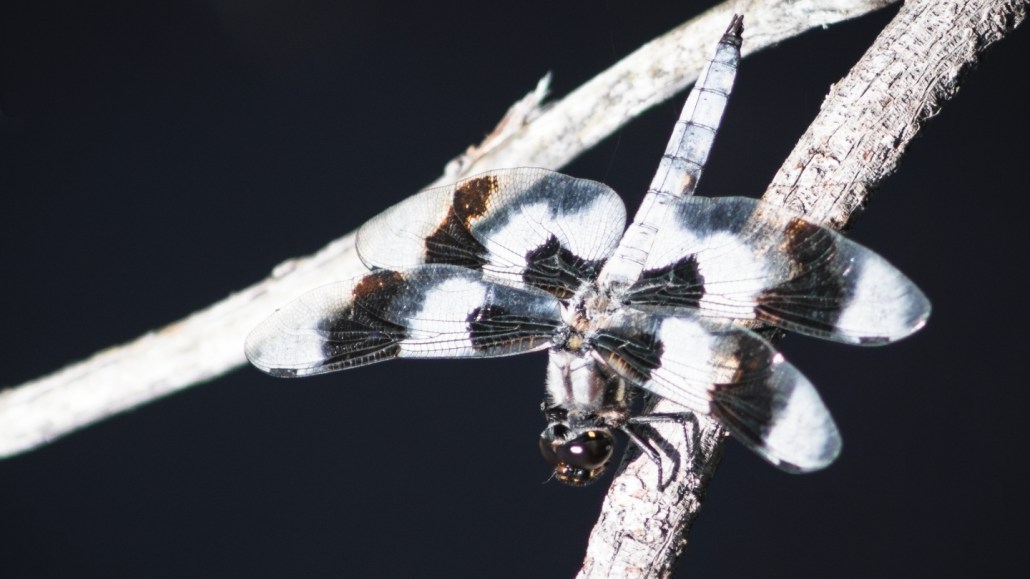
A male eight-spotted skimmer (Libellula forensis) perches on a twig with sunlight reflecting off the bright, waxy pruinescence on its abdomen. This waxy coating keeps males cool and may buffer some dragonfly species against the effects of a warming climate.
Sarah E. Nalley
Some male dragonflies have a waxy coat that keeps them cool while pursuing mates and may also help the insects shrug off a warming climate.
U.S. dragonfly species that produce the special wax are faring better in the face of ever-hotter and drier conditions compared with their waxless counterparts. This suggests the wax acts as a buffer against climate change, researchers report February 26 in the Proceedings of the National Academy of Sciences.
The wax gives some dragonflies a kind of “ecological superpower” for being able to use an expanded range of habitats, says Michael Moore, an evolutionary biologist at the University of Colorado Denver.
Moore’s team has studied how warming climates affect dragonfly coloration, and the researchers were itching to test a slightly different idea — whether lacking a trait involved with mating might limit species from inhabiting certain climates, especially as those climates rapidly change (SN: 7/14/21).
That’s why the researchers got interested in wax. In some dragonfly species, mature males exude an “unusual concoction” of hydrocarbons over their exoskeleton, Moore says. This bright, waxy, UV-reflective “pruinescence” forms a thick, frosty-looking layer that can cover the whole body. His team suspected that the wax shields dragonflies from water loss and overheating, a potential boon in hot, arid climes. Laboratory experiments confirmed this protective role, which could be a major advantage given many dragonflies’ mating behavior.
Male dragonflies expose themselves to plenty of heat and desiccation around sunlit ponds, defending a mating territory and watching for occasional female passersby. This is particularly the case in species that use a “percher” strategy, where the males rest exposed in the sun and only move to chase away intruders or pursue females. Moore and his team tested whether pruinescence is likely an adaptation for dealing with a brutally hot and dry mating strategy.
Using mating behavior data from 319 dragonfly species in North America, the team compared “percher” species with “flier” species, which continually buzz around and take drink breaks, allowing them to stay cool and hydrated. Sure enough, percher males were more likely to have the protective wax than their flier counterparts. The team developed a computer model for understanding how and when pruinescence evolved in dragonflies: It suggested that almost all wax-bearing lineages that became fliers lost their wax.
Wondering if pruinescence also allows the dragonflies to live in hotter and drier regions, the team next developed a database of over 387,000 geographic records for the dragonfly species. Male pruinescence was most common in the warmest and driest places. The team looked at an existing dataset of 60 U.S. dragonfly species and their status — either persisting or vanishing — within 385 geographic areas, and then calculated how these areas have changed in temperature and precipitation since the 1980s.
Waxless dragonflies are more likely to disappear from areas that are most rapidly warming and drying, the data show.
“But we’re not seeing that effect in the species that have evolved pruinescence, so the species with the wax [have been] basically insensitive to climate change across the United States,” Moore says.
This finding flips a common idea in evolutionary biology on its head. Environmental factors are usually considered brakes on the evolution of mating traits. In male deer, large antlers are costly to grow in a world with limited resources, for instance. But the new findings provide an opposite perspective, suggesting that for the dragonflies, even in a warming world, their mating wax hasn’t constrained them, and instead unlocked habitats that normally wouldn’t have been accessible.
Evolutionary biologist Agata Plesnar-Bielak at Jagiellonian University in Kraków, Poland, who was not involved with the study, says the findings show “the relationships between sexual selection and ecology are really complex and can take forms that might not be obvious at first glance.”
Species “need to be able to mate and reproduce in order to be successful,” Moore says. But most of the research about animals persisting in a warming world have focused on traits that help the species survive rather than reproduce under new climatic conditions (SN: 9/6/17). Moore calls for a broader view of forecasting what habitats will be suitable for species in the coming decades, considering whether the species can mate as the temperature rises.
And he wonders if other insects have sexual adaptations that could provide buffers against climate change. For example, some male cicadas can heat up to over 22 degrees Celsius higher than their surroundings when singing.
These insects must have some impressive biology for beating the heat during mating, Moore says.






